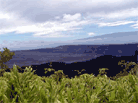Bishop Museum
The Bishop Museum is a really nice museum. Very few tourists tend to go
to Hawaii for serious museuming. To start with, there are not all that
many museums in Hawaii, and what museums there are have a great deal of
competition for the tourist dollar. Realizing that more people will fly
3,000 or more miles for restful tropical beaches or wild volcanic
jungles than for intellectual adventure, the Bishop Museum is aimed at
Hawaiians. Therein lies its charm. In many ways, this modern, urban
museum is much more Hawaiian than the typical luau.To start with, they have an excellent collection of Hawaiian art and artifacts. Hawaiian royalty exulted in their plumage and their flora and their fauna. The work, in plant matter and feathers is delicate, but well preserved and well presented. The igneous soils of Hawaii did not yield gemstones, but the lush climate yielded its own treasures, and these were worked for the glory of the kings and rulers of the land.
They also have displays of more modern works. No artist of any sensibility can work in these islands without being influenced. The materials, the forms, the wildness, the peace, the mix of cultures and stories alone are great source material for the mind. As Ansel Adams discovered and defined California with his camera, these artists are seeking to understand and present Hawaii. While not every effort succeeds or was to our taste, it was hard not to grasp their direction.
In truth, our favorite exhibit was the planetarium. They had a good old fashioned sky show rather than one of the high tech, gee whiz, recorded multimedia presentations that are so popular these days. There were the stars, some auxiliary visuals and an intelligent speaker who engaged his audience.
It is easy to think of the stars as being the same everywhere on earth. After all, there is no place on the earth's surface where one cannot see stars at night, and it takes a careful observer to note any changes in the patterns they form. But, the tropical sky is different from the temperate sky. The plane of the celestial sphere is inclined, so from the north, or the south, the constellations rise and fall in the sky. They appear and they disappear.
In the tropics, the stars flow from east to west and the constellations are not clusters, they are lines. Like the European explorers, the Polynesians who colonized the Pacific navigated by the stars. The guide star for Hawaii was Hokule'a, which we know as Arcturus. At Hawaii's latitude, it is overhead at its zenith, and so serves well for finding the islands. (For more on this, check out the museum web site).
We were fascinated. We were also the only ones in the planetarium who knew that the North Star was Polaris.
Whether your interest is in the stars, in nature, or man, you should check out the Bishop Museum. It is a great way to spend an afternoon when you get tired of the beach.


